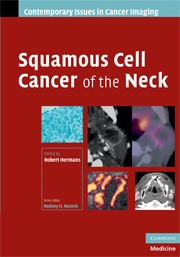Book contents
- Frontmatter
- Contents
- List of contributors
- Series Foreword
- Preface to Squamous Cell Cancer of the Neck
- 1 Introduction: epidemiology, pathology and clinical presentation
- 2 Radiotherapy and chemoradiotherapy of the head and neck
- 3 Surgery of the orocervical region
- 4 Laryngeal and hypopharyngeal cancer
- 5 Oral cavity and oropharyngeal cancer
- 6 Nasopharyngeal cancer
- 7 Neck and distant disease spread
- 8 Post-treatment imaging
- Index
- Plate section
- References
8 - Post-treatment imaging
Published online by Cambridge University Press: 24 August 2009
- Frontmatter
- Contents
- List of contributors
- Series Foreword
- Preface to Squamous Cell Cancer of the Neck
- 1 Introduction: epidemiology, pathology and clinical presentation
- 2 Radiotherapy and chemoradiotherapy of the head and neck
- 3 Surgery of the orocervical region
- 4 Laryngeal and hypopharyngeal cancer
- 5 Oral cavity and oropharyngeal cancer
- 6 Nasopharyngeal cancer
- 7 Neck and distant disease spread
- 8 Post-treatment imaging
- Index
- Plate section
- References
Summary
Introduction
Post-treatment imaging is carried out when a recurrent tumor is suspected, to confirm the presence of such a lesion and to determine its extent. The extent of a recurrent cancer is important information for determining the possibility of salvage therapy.
Imaging may also be used to monitor tumor response and to try to detect recurrent or persistent disease before it becomes clinically evident, possibly with a better chance for successful salvage. However, early tumor recurrence may be difficult to distinguish from tissue changes induced by therapy. Therefore, the expected changes on imaging studies after treatment of a head and neck cancer should be clearly understood when analyzing images.
Treatment complications are less frequent than tumor recurrences, but these conditions may sometimes be clinically difficult to distinguish. Although definitive distinction between treatment-induced necrosis and recurrent tumor may also be difficult radiologically, imaging findings may be helpful in guiding treatment and assessing response to specific treatment.
Expected tissue changes after radiotherapy
The changes visible on post-treatment computed tomography (CT) and magnetic resonance imaging (MRI) depend on the radiation dose and rate, the irradiated tissue volume and the time elapsed since the end of radiation therapy. Changes which may be seen include (Fig. 8.1):
thickening of the skin and platysma muscle
reticulation of the subcutaneous fat and the deep tissue fat layers
edema in the retropharyngeal space
increased enhancement of the major salivary glands, followed by size reduction of these glands: postirradiation sialadenitis
atrophy of lymphatic tissue, in both the lymph nodes and Waldeyer's ring
[…]
- Type
- Chapter
- Information
- Squamous Cell Cancer of the Neck , pp. 135 - 150Publisher: Cambridge University PressPrint publication year: 2008



